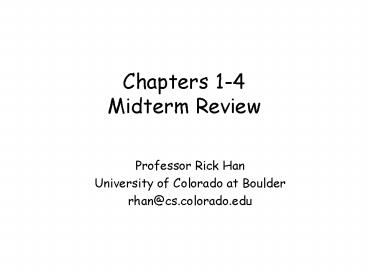Chapters 14 Midterm Review - PowerPoint PPT Presentation
1 / 16
Title: Chapters 14 Midterm Review
1
Chapters 1-4Midterm Review
- Professor Rick Han
- University of Colorado at Boulder
- rhan_at_cs.colorado.edu
2
Announcements
- HW 1, 2, 3 see profs office hours
- Solutions to HW 2 and 3 online
- Solutions to HW 4 online by tonight
- Programming Assignment 3 due after Spring Break
- Best practices code
- TCP/IP Sockets in C Practical Guide for
Programmers Michael Donahoo and Kenneth
CalvertThird edition of Peterson and Davie - Im trying to obtain free evaluation copies of
both will have more say later
3
Midterm
- Midterm March 13
- Through Chapter 4 Network Layer
- Excluding 2.9 (network adaptors), 3.4 (switching
hardware) - 75 minutes
- In class
- Closed book
- Calculator OK
- 3-4 multipart questions (multiple sections)
- maybe some short-answer/multiple-choice questions
- About 20 minutes for each long question
4
Potential Topics for Midterm
- List is not all-inclusive some topics may appear
on midterm not listed here - How does ___ work? Why is it used?
- Physical
- Propagation delay, bandwidthdelay product
- Byte stuffing
- Error detection/correction, e.g. checksums
- Data-link
- Reliable protocols
- Stop-and-Wait
- Go-Back-N cumulative ACKs, window-based
flow-control - Selective Repeat selective ACKs
5
Potential Topics for Midterm (2)
- MAC
- Aloha, Slotted Aloha
- CSMA Listen before talk
- CSMA/CD Ethernet Listen while talk
- exponential backoff
- CSMA/CA wireless Ethernet
- Token Ring
- Ethernet Hubs/Repeaters
- Ethernet Bridges/Switches
- How do bridges build their forwarding tables?
- How are Spanning Trees constructed?
6
Potential Topics for Midterm (3)
- Network
- Virtual circuit routing
- IP
- Addressing, CIDR
- ARP
- First, Broadcast on Ethernet
- DHCP
- DHCP Relay to a DHCP Server
- ICMP
- How do ping and traceroute use ICMP?
7
Potential Topics for Midterm (4)
- Network
- IP
- Distance-vector routing (RIP)
- Distributed Bellman-Ford
- Bouncing effect, counting-to-infinity, split
horizon - Link-state routing (OSPF)
- Flooding of LSPs Dijkstra
- Link-state cost metrics
- Inter-domain routing (BGP)
- Path vector exchanged between ASs
8
Sample Problems
- Reliable protocols
- Suppose a host X wishes to transmit packets to a
host Y using a reliable protocol. Assume that
the propagation delay is D in each direction, the
bandwidth is B bits/sec in each direction, and
there are no other delays in the network or
endpoints. Assume the speed of light C is 3108
m/s. Suppose a stop-and-wait protocol reliably
sends packets of fixed size P from X to Y, and
that each packet arrives without error at host Y
and is ACKnowledged immediately. Each ACK is of
fixed size A and is sent from Y to X, arriving
without error at host X. Assume that P and A are
both much less than the bandwidthdelay product
of the link. - (a) What is the roundtrip time of the link,
beginning from the time the first bit of packet P
is sent to the time the last bit of ACK A is
received, expressed as a function of A, B, C, D
and P? - Answer RTT forward delay reverse delay (D
P/B) (D A/B) 2D (PA)/B (assuming full
duplex)
9
Sample Problems (2)
- Reliable protocols
- (b) What is the fraction of each roundtrip time
that the stop-and-wait protocol spends waiting
before it can send new data packets P, expressed
as a function of A, B, C, D, and P? Hint its
a ratio of expressions, not numbers - Answer fraction of each RTT devoted to waiting
1 - P/B / RTT - 1 - P / 2DB P A
- 2DB A / 2DB P A (assuming full
duplex)
10
Sample Problems (3)
- Ethernet bridges
- For the Figure above, fill in the bridge
forwarding table after each of the following
sequence of events. The table should expand
along with the events.
11
Sample Problems (4)
- Ethernet bridges
12
Sample Problems (5)
- Ethernet bridges (answer)
13
Sample Problems (6)
- Link state routing
- Suppose now that link-state routing is applied to
the above network topology (all links are up and
running). Assume that all link information has
been reliably flooded via LSPs to all nodes.
Assume that node B is the root node of the
shortest path tree. Fill in the table below that
iteratively adds nodes onto the shortest path
tree using Dijkstras shortest path algorithm
with B as the root. Here is Dijkstras algorithm
14
Sample Problems (7)
- Link state routing
- Initialize shortest path tree SPT B
- For each n not in SPT, C(n) l(s,n)
- While (SPTltgtN)
- SPT SPT U w such that C(w) is minimum for all
w in (N-SPT) - For each n in (N-SPT), C(n) MIN (C(n), C(w)
l(w,n)) - where N set of nodes in graph, l(i,j) link
cost between i,j ( infinity if not neighbors),
SPT set of nodes in shortest path tree thus
far, B source node, C(n) cost of path from B
to node n. In case of ties in cost, choose the
node with the lowest id, AltBltCltDltEltF.
15
Sample Problems (8)
- Link state routing
16
Sample Problems (9)
- Link state routing (answers)































